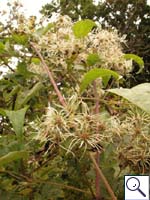|
||||||
|
CLEMATIS. Traveller's Joy, Clematis and Virgin's-bowers. [Ranunculaceae] |
|
|
Traveller's-joy (C. vitalba) is the only native species of Clematis in Britain, although six other species have been introduced including Virgin's-bower (C. flammula), Early Virgin's-bower (C. cirrhosa), Himalayan Clematis (C. montana), Orange-peel Clematis (C. tangutica) and Purple Clematis (C. viticella). Four British miners are recorded on Clematis. The agromyzid Phytomyza clematidis is recorded feeding in the seed head of Clematis vitalba in Britain and elsewhere. A key to the European miners recorded on Clematis is provided in Bladmineerders van Europa. |
|
Key for the identification of the known mines of British |
1a > Leaf miner: Mine beginning on lower surface, the linear upper surface section eaten out somewhat irregularly at sides (Spencer, 1972b: 80). Corridor mine; the corridor begins with a lower-surface spiral or patch. The upper-surface corridor that follows has very irregular sides, and frass in long pearl chains. Pupation outside the mine. A narrow gallery similar to P. vitalbae, but starting on the lower surface. The linear upper section eaten out irregularly at sides. |
|
Phytomyza fulgens Hendel, 1920 [Diptera: Agromyzidae]. |
1b > Leaf miner:. A long narrow upper surface mine. Pupation external (Spencer, 1972b: 70 (fig. 227), 73; Spencer, 1976: 525, 526 (fig. 920)). Oviposition in the leaf lower surface. After a short initial corridor of a few mm length the larva makes an upper-surface corridor that mostly begins with a dense knot in the leaf tip. Frass in long pearl chains along the sides. In fresh material primary feeding lines are apparent. Pupation outside the mine; exit slit in the lower epidermis. The mine often causes the leaf to be malformed and wrinkled. Feeding punctures in the lower surface. The larva forms a long narrow upper surface mine. Most mines start close to the leaf tip. The larva exits through a slit. Pupation is external. |
|
Phytomyza vitalbae Kaltenbach, 1872 [Diptera: Agromyzidae]. |
1c > Leaf miner: The first instar larva forms a shallow winding linear mine on the underside of the leaf, later forming a broad upper surface mine (Spencer, 1976: 436); initially frass in a narrow central line which after the larva moves to the upperside of the leaf is in irregular black lumps. Pupation internal (Spencer, 1976: 436). |
|
Phytomyza kaltenbachi Hendel, 1922 [Diptera: Agromyzidae]. |
1d > Leaf-miner: Mine linear but normally developing into secondary blotch, feeding confined to apex of a leaf segment (Spencer, 1972b: 70 (fig. 225); Spencer, 1976: 374, 375 (fig. 652)). Pupation normally external, but Lundquist (1947) records that 8 of 10 larvae pupariumted in the mine in Sweden. The mine is also dexcribed and illustrated in British leafminers. |
|
Phytomyza anemones Hering, 1925 [Diptera: Agromyzidae]. |
| Last updated 02-Jul-2019 Brian Pitkin | ||

